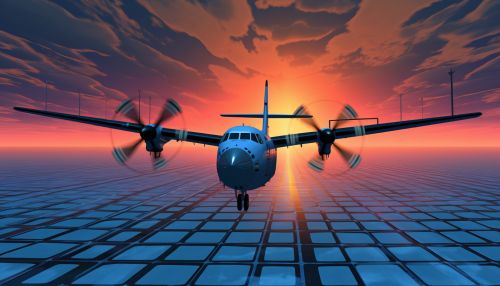Panel Methods
Introduction
Panel methods are a type of computational fluid dynamics (CFD) technique used in aerodynamics and hydrodynamics for the calculation of fluid flow around surfaces. These methods are based on the representation of the surface of the body in the flow field by a distribution of sources, sinks, and vortices, which are then solved to find the flow field around the body.


History
The development of panel methods can be traced back to the early 20th century, with the work of Ludwig Prandtl and his students at the University of Göttingen in Germany. They developed the concept of the boundary layer and the idea of representing the flow field around a body by a distribution of singularities.
Mathematical Foundation
The mathematical foundation of panel methods is based on the potential flow theory and the boundary layer theory. The potential flow theory provides a mathematical description of the flow field outside the boundary layer, while the boundary layer theory describes the flow field within the boundary layer.
The potential flow around a body is represented by the Laplace's equation, which is a second-order partial differential equation. The solution of this equation provides the velocity potential, which can be used to calculate the flow field around the body.
The boundary layer theory, on the other hand, is based on the Navier-Stokes equations, which are a set of nonlinear partial differential equations that describe the motion of viscous fluid substances. The solution of these equations provides the velocity and pressure fields within the boundary layer.
Panel Methodology
In panel methods, the surface of the body in the flow field is divided into small panels, each of which is assumed to have a constant distribution of sources, sinks, and vortices. The strength of these singularities is then calculated by solving a system of linear equations, which are derived from the boundary conditions on the surface of the body and the flow field around it.
The solution of these equations provides the velocity and pressure fields around the body, which can be used to calculate the aerodynamic or hydrodynamic forces and moments on the body.
Applications
Panel methods have been widely used in the design and analysis of aircraft, ships, and other bodies in fluid flow. They are particularly useful in the preliminary design stage, where a quick and accurate estimation of the aerodynamic or hydrodynamic performance of the body is required.
In addition to their use in design and analysis, panel methods have also been used in the study of fluid-structure interaction, aeroacoustics, and other areas of fluid dynamics.
Limitations
While panel methods are a powerful tool in fluid dynamics, they do have some limitations. They are based on the potential flow theory, which assumes that the flow is inviscid, incompressible, and irrotational. These assumptions are not always valid, particularly in high-speed flows or flows with strong shock waves.
Furthermore, panel methods are based on the representation of the flow field by a distribution of singularities, which can lead to numerical instabilities if not handled properly. Finally, panel methods require a good quality surface mesh, which can be difficult to generate for complex geometries.
Future Developments
Despite these limitations, panel methods continue to be an active area of research in fluid dynamics. Recent developments include the integration of panel methods with other CFD techniques, such as the finite volume method and the finite element method, to overcome the limitations of the potential flow theory.
Furthermore, advances in computer technology have made it possible to solve larger and more complex problems with panel methods, opening up new areas of application.
